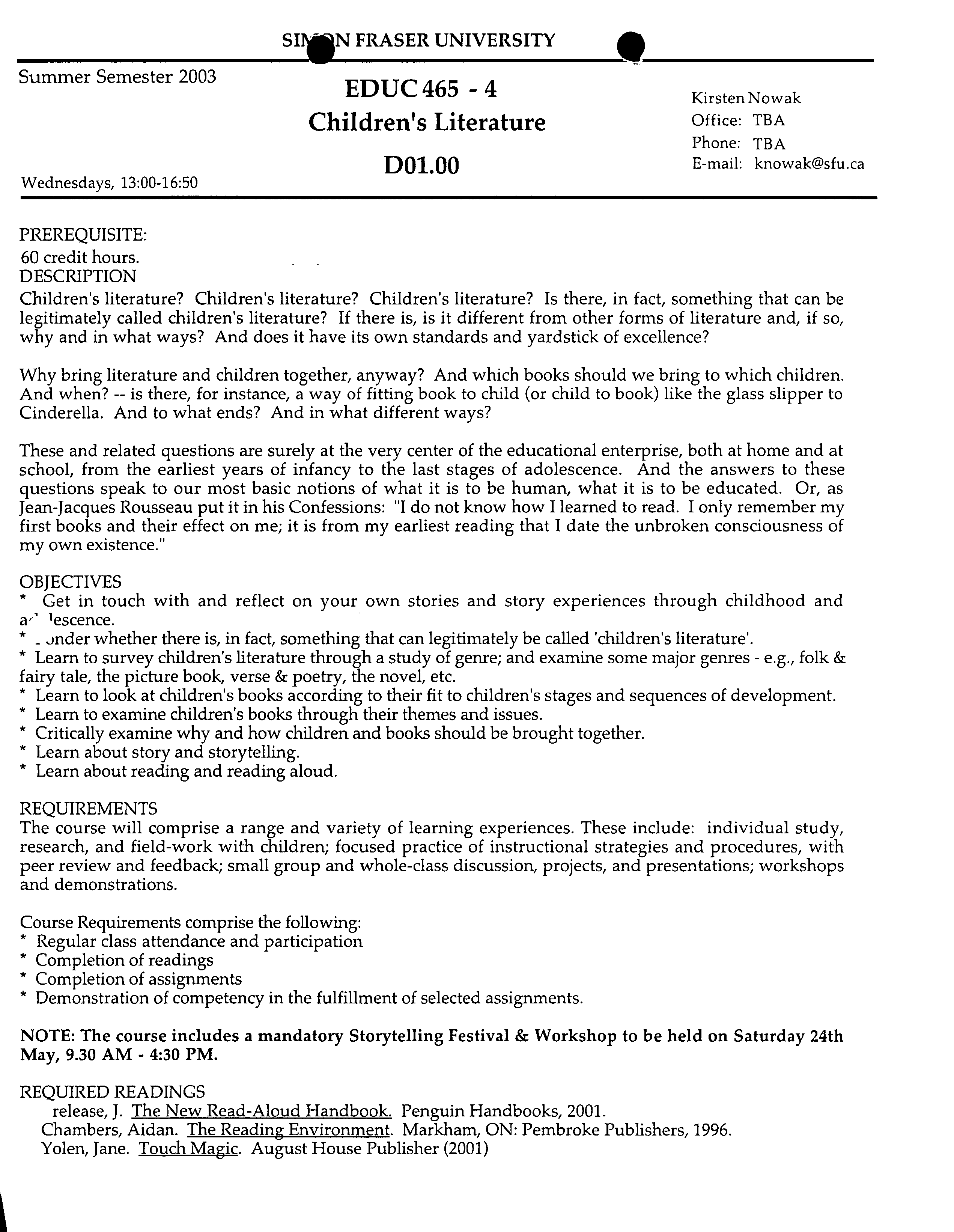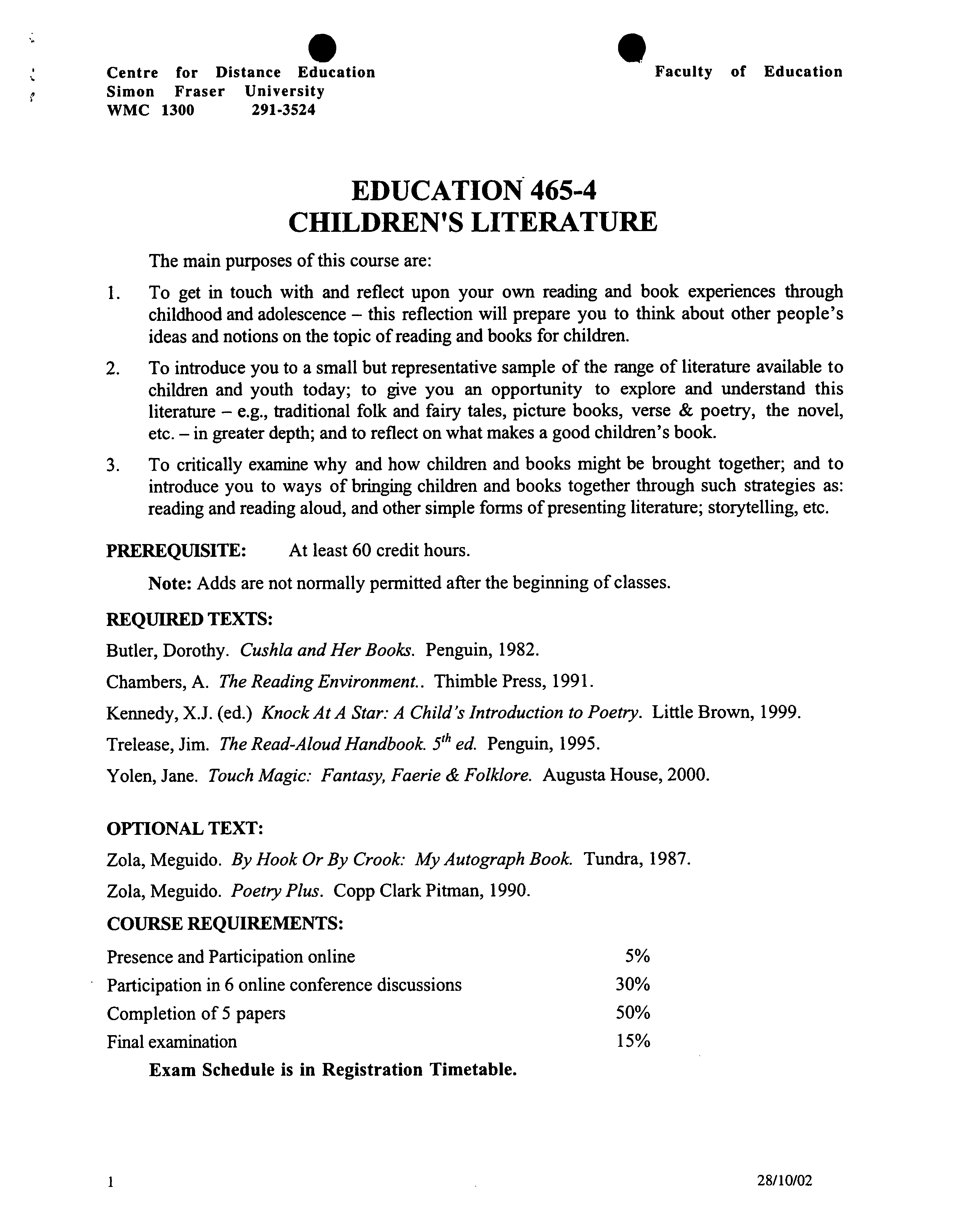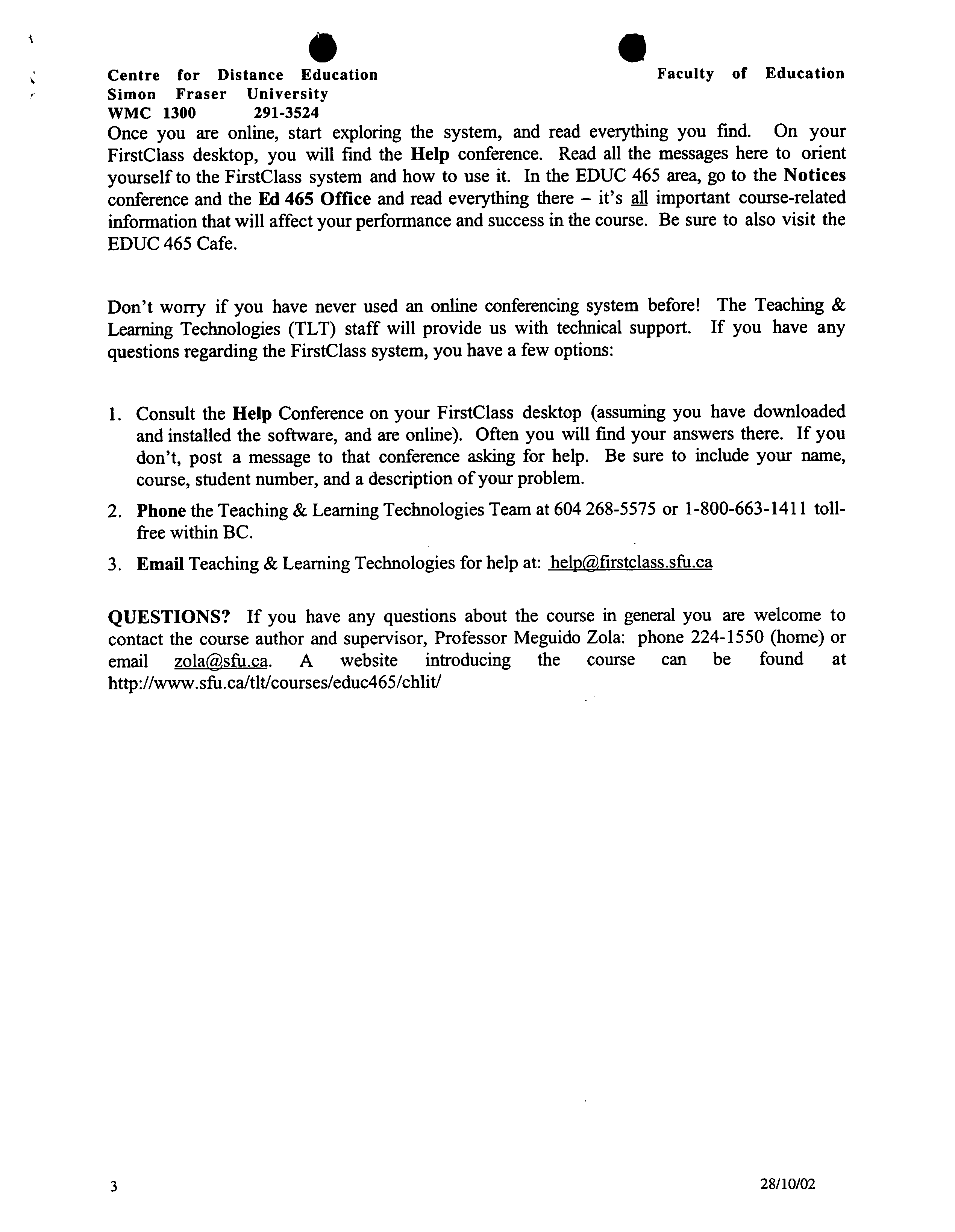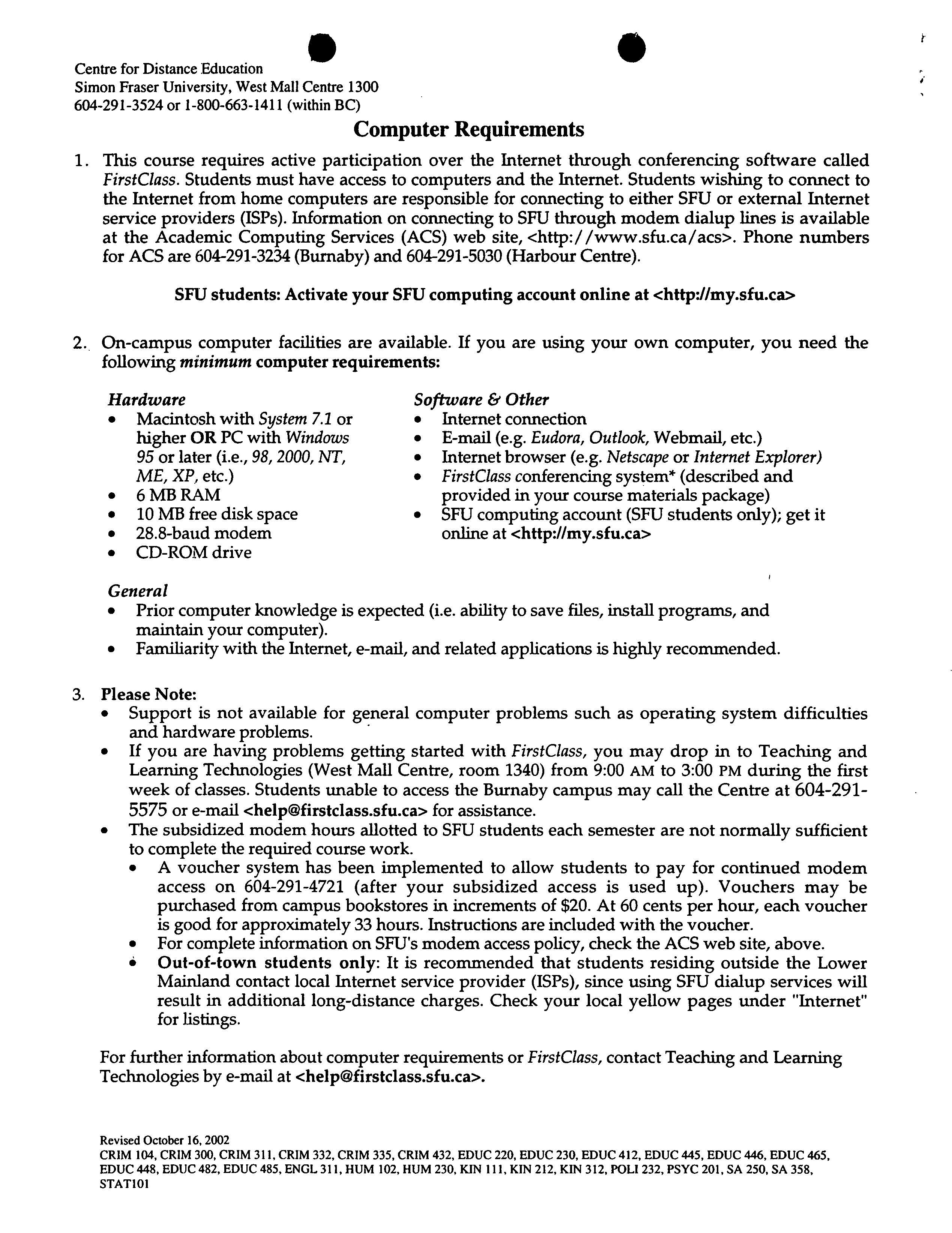SIN FRASER UNIVERSITY ?
Q
Summer Semester 2003
?
EDUC 465 - 4
?
Kirsten Nowak
Children's Literature
?
Office: TBA
Phone: TBA
DO1.00
?
E-mail: knowak@sfu.ca
Wednesdays, 13:00-16:50
PREREQUISITE:
60 credit hours.
DESCRIPTION
Children's literature? Children's literature? Children's literature? Is there, in fact, something that can be
legitimately called children's literature? If there is, is it different from other forms of literature and, if so,
why and in what ways? And does it have its own standards and yardstick of excellence?
Why bring literature and children together, anyway? And which books should we bring to which children.
And when? -- is there, for instance, a way of fitting book to child (or child to book) like the glass slipper to
Cinderella. And to what ends? And in what different ways?
These and related questions are surely at the very center of the educational enterprise, both at home and at
school, from the earliest years of infancy to the last stages of adolescence. And the answers to these
questions speak to our most basic notions of what it is to be human, what it is to be educated. Or, as
Jean-Jacques Rousseau put it in his Confessions: "I do not know how I learned to read. I only remember my
first books and their effect on me; it is from my earliest reading that I date the unbroken consciousness of
my own existence."
OBJECTIVES
* Get in touch with and reflect on your own stories and story experiences through childhood and
a" 1escence.
* - under whether there is, in fact, something that can legitimately be called 'children's literature'.
* Learn to survey children's literature through a study of genre; and examine some major genres - e.g., folk &
fairy tale, the picture book, verse &r poetry, the novel, etc.
• Learn to look at children's books according to their fit to children's stages and sequences of development.
• Learn to examine children's books through their themes and issues.
• Critically examine why and how children and books should be brought together.
• Learn about story and storytelling.
* Learn about reading and reading aloud.
REQUIREMENTS
The course will comprise a range and variety of learning experiences. These include: individual study,
research, and field-work with children; focused practice of instructional strategies and procedures, with
peer review and feedback; small group and whole-class discussion, projects, and presentations; workshops
and demonstrations.
Course Requirements comprise the following:
* Regular class attendance and participation
* Completion of readings
* Completion of assignments
* Demonstration of competency in the fulfillment of selected assignments.
NOTE: The course includes a mandatory Storytelling Festival
&
Workshop to be held on
Saturday 24th
May, 9.30 AM - 4:30 PM.
REQUIRED READINGS
release,
J.
The New Read-Aloud Handbook. Penguin Handbooks, 2001.
Chambers, Aidan. The Reading Environment. Markham, ON: Pembroke Publishers, 1996.
Yolen, Jane. Touch Magic. August House Publisher (2001)
S ?
.
Centre for Distance Education ?
Faculty of Education ?
Simon Fraser University
WMC 1300 ?
291-3524
EDUCATION 465-4
?
CHILDREN'S LITERATURE
The main purposes of this course are:
1.
To get in touch with and reflect upon your own reading and book experiences through
childhood and adolescence - this reflection will prepare you to think about other people's
ideas and notions on the topic of reading and books for children.
2.
To introduce you to a small but representative sample of the range of literature available to
children and youth today; to give you an opportunity to explore and understand this
literature - e.g., traditional folk and fairy tales, picture books, verse & poetry, the novel,
etc. - in greater depth; and to reflect on what makes a good children's book.
3.
To critically examine why and how children and books might be brought together; and to
introduce you to ways of bringing children and books together through such strategies as:
reading and reading aloud, and other simple forms of presenting literature; storytelling, etc.
PREREQUISITE: ?
At least 60 credit hours.
Note:
Adds are not normally permitted after the beginning of classes.
REQUIRED TEXTS:
Butler, Dorothy.
Cushla and Her Books.
Penguin, 1982.
Chambers, A.
The Reading Environment..
Thimble Press, 1991.
Kennedy, X.J. (ed.) Knock AtA Star: A Child's Introduction to Poetry.
Little Brown, 1999.
Trelease, Jim. The Read-Aloud Handbook.
5th
ed.
Penguin,
1995.
Yolen, Jane.
Touch Magic: Fantasy, Faerie & Folklore.
Augusta House, 2000.
OPTIONAL TEXT:
Zola, Meguido.
By Hook Or By Crook: My Autograph Book.
Tundra, 1987.
Zola, Meguido.
Poetry Plus. Copp
Clark Pitman, 1990.
COURSE REQUIREMENTS:
Presence and Participation online ?
5%
Participation in 6 online conference discussions ?
30%
Completion of
5
papers ?
50%
Final examination ?
15% ?
Exam Schedule is in Registration Timetable.
1 ?
28/10/02
. ?
S
Centre for Distance Education
?
Faculty of Education
Simon Fraser University
WMC 1300
?
291-3524
PLEASE NOTE: This course is delivered ONLINE using a computer conferencing system
called FirstClass Intranet Client. Access to a computer and modem is required. See page
4 for details.
SUPPLEMENTARY FEES:
?
Course Materials & Service Fee
?
$30
Deposit for Additional Materials
$25
ONLINE COMMUNICATION AND THE FIRSTCLASS SYSTEM:
This course uses FirstClass, an online conferencing system, for communication and
submission/return of your assignments. Although it may be a little challenging at first, experience
shows that students find this way of learning and communicating rewarding and convenient.
If past experience is a guide, most of you will really enjoy learning and conferencing online.
It allows you to connect with others. It allows you to read others' work and to communicate
with anyone in the class - with opportunity for both synchronous and asynchronous
conversation and discussion through your computer.
Online learning is also convenient: unlike students in previous semesters, you will not have
to drive to the university, or mail or fax your assignments. Nor will you have to experience the
delays involved in getting your assignments back through the mail: you will receive detailed and
comprehensive feedback on your work within 3
—5
days.
The course is designed so that you post one assignment online a week - for a total of 6
Postings and follow-ups (online small-group discussions) and
5
more formal Papers. You are
cautioned that this kind of schedule is demanding, and you should not enrol in this course if you
are not prepared for the self-discipline that such a schedule calls for.
GETTING STARTED WITH FIRSTCLASS:
The sooner you get online, the better. You will be assigned to an online tutorial group soon after
you register and you will be required to post a message to your group
during the first week of
the course.
You will be receiving a CD-ROM in your course materials from the Centre for Distance
Education, which has all the software you will need for this course. On the CD-ROM and in
your red folder, you will find an "Installation Guide", containing explicit instructions on how to
install the software on to your computer. Follow the instructions to the letter.
2 ?
28/10/02
Centre for Distance Education
?
Faculty of Education
Simon Fraser University
WMC 1300
?
291-3524
Once you are online, start exploring the system, and read everything you find. On your
FirstClass desktop, you will find the
Help
conference. Read all the messages here to orient
yourself to the FirstClass system and how to use it. In the EDUC
465
area, go to the
Notices
conference and the
Ed 465 Office
and read everything there - it's all important course-related
information that will affect your performance and success in the course. Be sure to also visit the
EDUC
465
Cafe.
Don't worry if you have never used an online conferencing system before! The Teaching &
Learning Technologies (TLT) staff will provide us with technical support. If you have any
questions regarding the FirstClass system, you have a few options:
1.
Consult the
Help
Conference on your FirstClass desktop (assuming you have downloaded
and installed the software, and are online). Often you will find your answers there. If you
don't, post a message to that conference asking for help. Be sure to include your name,
course, student number, and a description of your problem.
2.
Phone
the Teaching & Learning Technologies Team at 604
268-5575
or 1-800-663-1411 toll-
free within BC.
3.
Email
Teaching & Learning Technologies for help at: help@firstclass.sfu.ca
QUESTIONS?
If you have any questions about the course in general you are welcome to
contact the course author and supervisor, Professor Meguido Zola: phone 224-1550 (home) or
email zola@sfu.ca
. A website introducing the course can be found at
http://www.sfu.ca/tlticourses/educ465/chlit/
3 ?
28/10/02
. ?
.
Centre for Distance Education
Simon Fraser University, West Mall Centre 1300
604-291-3524 or 1-800-663-1411 (within BC)
Computer Requirements
This course requires active participation over the Internet through conferencing software called
FirstClass.
Students must have access to computers and the Internet. Students wishing to connect to
the Internet from home computers are responsible for connecting to either SFU or external Internet
service providers (ISPs). Information on connecting to SFU through modem dialup lines is available
at the Academic Computing Services (ACS) web site, <http://www.sfu.ca/acs
>. Phone numbers
for ACS are 604-291-3234 (Burnaby) and 604-291-5030 (Harbour Centre).
SFU students: Activate your SFU computing account online at
<http:/Imy.sfu.ca >
2.. On-campus computer facilities are available. If you are using your own computer, you need the
following
minimum
computer requirements:
Hardware
• Macintosh with
System 7.1
or
higher
OR
PC with
Windows
95
or later (i.e.,
98, 2000, NT,
ME, XP,
etc.)
• 6MBRAM
• 10 MB free disk space
• 28.8-baud modem
• CD-ROM drive
Software & Other
• Internet connection
• E-mail (e.g.
Eudora, Outlook,
Webmail, etc.)
• Internet browser (e.g. Netscape
or
Internet Explorer)
• FirstClass
conferencing
system*
(described and
provided in your course materials package)
• SFU computing account (SFU students only); get it
online at <http://my.sfu.ca >
General
• Prior computer knowledge is expected (i.e. ability to save files, install programs, and
maintain your computer).
• Familiarity with the Internet, e-mail, and related applications is highly recommended.
3.
Please Note:
• Support is not available for general computer problems such as operating system difficulties
and hardware problems.
• If you are having problems getting started with
FirstClass, you
may drop in to Teaching and
Learning Technologies (West Mall Centre, room 1340) from 9:00 AM to 3:00
PM
during the first
week of classes. Students unable to access the Burnaby campus may call the Centre at 604-291-
5575 or e-mail
<help@firstclass.sfu.ca
>
for assistance.
• The subsidized modem hours allotted to SFU students each semester are not normally sufficient
to complete the required course work.
• A voucher system has been implemented to allow students to pay for continued modem
access on 604-291-4721 (after your subsidized access is used up). Vouchers may be
purchased from campus bookstores in increments of $20. At 60 cents per hour, each voucher
is good for approximately 33 hours. Instructions are included with the voucher.
• For complete information on SFU's modem access policy, check the ACS web site, above.
o
Out-of-town students only:
It is recommended that students residing outside the Lower
Mainland contact local Internet service provider (ISPs), since using SFU dialup services will
result in additional long-distance charges. Check your local yellow pages under "Internet"
for listings.
For further information about computer requirements or
FirstClass,
contact Teaching and Learning
Technologies by e-mail at
<help@firstclass.sfu.ca >.
Revised October 16, 2002
CRIM 104, CRIM 300, CRIM 311, CRIM 332, CRIM 335, CRIM 432,
EDUC
220,
EDUC
230,
EDUC
412,
EDUC
445,
EDUC
446,
EDUC
465,
EDUC
448,
EDUC
482,
EDUC
485,
ENGL
311, HUM 102, HUM 230, KIN 111, KIN 212, KIN 312,
POLl
232, PSYC 201, SA 250, SA 358,
STATIOI





